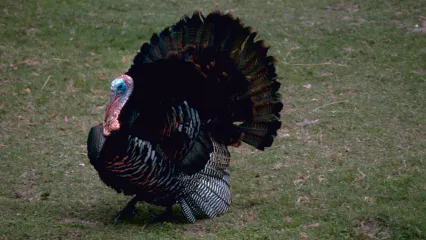
Description
Yellow-bellied sapsuckers are variable in coloration, but most have white and brown coloration on their backs with thin black horizontal bars. The wings are black and a vertical white stripe follows the contour of the folded wing. This stripe often creates a sharp contrast with the dark wing and is a good identifying characteristic. The head and face is boldly patterned black, white and poppy-red. Both males and females have a red cap or forehead (traditionally found only on male woodpeckers), and males have a red throat patch. Both males and females have a black bib, or chest shield, around the lower neck.
Size
7-9 inches long. 13-15 inch wingspan.
Habitat
The yellow-bellied sapsucker is found statewide during the fall and winter months (October through early April). These sapsuckers are the most migratory of woodpeckers with summer and wintering ranges barely overlapping. The nesting season is spent in Canada and the northern U.S> where preferred sap-producing trees (maple and birch) are more abundant. The birds later migrate to the southeast to escape harsh winters. During the winter months, sapsuckers may drill holes in a wide variety of tree species, but usually choose trees with a higher sugar content in their sap such as pecans and maples, or younger trees and those with relatively thin bark. A total of four species of sapsuckers can be found in the United States. The Williamson’s, red-breasted, and red-naped sapsuckers occupy smaller ranges in the western half of the U.S.
Life Cycle
As the name implies, the yellow-bellied sapsucker’s diet consists largely of tree sap. In fact, sapsucker’s tongues are shorter than most woodpeckers and have a specialized brush-tip. In early spring, this woodpecker drills circular holes to access the tree’s xylem (specialized cells beneath the bark that carry water, sugar and minerals upward through the tree) and the sap flowing upward. Later, after the trees leaf out, yellow-bellied sapsuckers shift to drilling shallow, rectangular holes to access the trees’ phloem (cells beneath the bark that distribute sugary sap from the leaves to the rest of the tree). The resulting sap wells must be regularly maintained to keep sap flowing outward. Sap wells typically are drilled in a horizontal line, with new well lines drilled immediately above old ones. Several species of wildlife may take advantage of the sapsucker’s wells. Porcupines, chipmunks, squirrels, some species of bats and even hummingbirds have been known to feed on the exposed sap. In addition to their high-sugar diet of tree sap, yellow-bellied sapsuckers forage for insects, especially those trapped in their sap wells. Though ants are preferred, yellow-bellied sapsuckers will also eat spiders, grasshoppers, stink bugs, crickets, caterpillars and moths. Fruit is another important food source, especially in winter.
How To Observe
If you’re interested in attracting yellow-bellied sapsuckers or other species of woodpeckers to your property, consider offering a suet mixture. Other ideas for attracting winter birds can be found in Landscaping for Wildlife: A Guide to the Southern Great Plains.


